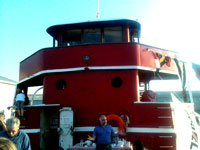
From the deck of the Mary Whalen
Today, in the United States, is National Maritime Day. There is a presidential proclamation and everything. The day, May 22nd, was chosen because that was the date that the American steamship Savannah set sail from Savannah, Georgia in 1818 on the first ever transoceanic voyage under steam power. Well, partially under steam power, at any rate. Perhaps, tellingly, the Savannah was not a commercial success and was converted back to a pure sailing ship shortly after her return voyage from Europe.
For all intents and purposes, the United States no longer has a significant merchant marine in international trade. In 1955, the US flag fleet represented almost 25% of the world’s overall tonnage. Today the fleet represents less than 2% of total world tonnage. But we still have a National Maritime Day, as authorized by Congress in 1933.
Last night, I had the pleasure to attend the 75th birthday party for and on the historic tanker Mary A. Whalen. (My thanks to Carolina and the great folks at Portside New York. A great party.) It was a beautiful evening, but as I looked out at the empty piers and sheds on the Atlantic Basin I was reminded of how different the Brooklyn waterfront was when I first saw it almost forty years ago, when it was bustling with hundreds of ships and thousands of tugs. The now empty sheds were full of general cargo from all over the world and the empty Brooklyn waterfront streets were crowded with trucks carrying cargo to or from the docks. Walking along Red Hook’s Imlay Street past the massive New York Dock Company warehouses felt like stumbling into the set of a post-apocalyptic movie, except with fewer zombies.
Container ships, which revolutionized shipping and which were developed in the United States, still call at Red Hook, Staten Island and Port Newark and Port Elizabeth, but the US container ship operators are all gone or swallowed up by foreign operators. Virtually the only container ships flying the US flag in international trade these days are foreign-owned ships operating under the Maritime Administration’s Maritime Security Program (MSP) which pays subsidies to operate the ships under the US flag. According to the Maritime Administration, US flag ships cost roughly 2.7 times more to operate than foreign flag ships, with crew costs being over five times higher. Ironically, while these US flag ships have foreign owners, US owners operate a much larger fleet of of foreign flagged ships in international trade.
The US also has a tax structure that is particularly unattractive to US flag operators. This is a particular irony as the US tax code allows foreign operators based in the US to pay little or no Federal taxes. Carnival Corp is a prime example.
Last night as I watched the sunset from the quiet Brooklyn docks I was reminded of the wisdom of Pogo. “We have met the enemy and he is us.” A happy National Maritime Day to all.

Ultimately its all about cheap labor and maximizing profits for the owners. It always has been. Sad, though. Alex Roland et al discuss this at length in their book The Way of the Ship; America’s Maritime History Reenvisioned 1600-2000. American Maritime History Project.
In many respects this no different than so many industries. The terrible sweatshops of the Garment District in Manhattan moved to the Carolinas and now on to Bangladesh.
In fairness, though the US liner shipping industry hid behind subsidies for long enough to grow thoroughly non-competitive. Many of the wounds which led to the extinction of the American deep sea shipping industry were self inflicted. The companies, the unions and the government all share in the blame.
It is ultimately about what the consumer is willing to pay. If the consumer is always looking for the cheapest thing, they are going to get the “cheapest thing”. 90% percent of the time, low cost maritime services, are going to do just as good a job as the higher cost ones. That 10% of the time that they do not do as good a job is what drives up the overall costs (insurance (in all of its forms) is one) for everyone.
Rick nailed it, with US flag services becoming increasingly uncompetitive. Repeal the Jones Act and let US flag vessels operate like everyone else – build and maintain the ships anywhere (to ABS/LR/DNV etc standards), crew them with anyone (US minimum wage at least), and let anyone else meeting these standards operate between US ports. We would soon see coastal freight and passenger/car ferries, and reasonable freight rates for Hawaii reflected in lower prices there. Allow foreign airlines access to the US market and domestic air fares would drop as well.